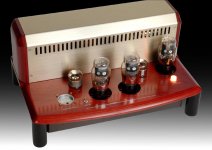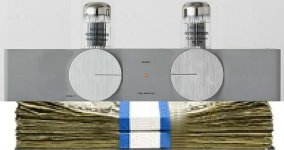Mosquito, Well done...I see how you painted over those flimsy "tactile" up/down/left/right & select buttons. It looks like a "styling design" with those buttons!
I guess you will have most all large components topside as the ol' DVD is very thin (height).
I tend to close my eyes when listening to music, so 'Ugly' doesn't factor into it. But I do like a great looking design.
Myself, I am using an old rectangular steel pan as one half of my chassis....the bottom half is quebracho WOOD. Down here you have to go with what you have.
__________________________________________________________Rick.....
I guess you will have most all large components topside as the ol' DVD is very thin (height).
I tend to close my eyes when listening to music, so 'Ugly' doesn't factor into it. But I do like a great looking design.
Myself, I am using an old rectangular steel pan as one half of my chassis....the bottom half is quebracho WOOD. Down here you have to go with what you have.
__________________________________________________________Rick.....
That's right Richard, the transformer, tubes, and the large knob, are placed on top.
Rearside there is no place for the normal IEC chassis power plug, so I put a Cannon type connector for the mains. All the other stuff is placed inside. There is room enough, cause it is a very simple circuit (the Bruce Rozemblit`s 12AU7 preamplifier, build up to the letter)
Rearside there is no place for the normal IEC chassis power plug, so I put a Cannon type connector for the mains. All the other stuff is placed inside. There is room enough, cause it is a very simple circuit (the Bruce Rozemblit`s 12AU7 preamplifier, build up to the letter)
I remember a designer who was daft enough to use wood around a 6C33 socket...wood bowed and he had to change that design.
Before and after:


The funny thing is that he later found out [FONT=Arial,Helvetica,Geneva,Swiss,SunSans-Regular]that the wooden transformer cover dress plate also bowed a bit.[/FONT]😀
Before and after:


The funny thing is that he later found out [FONT=Arial,Helvetica,Geneva,Swiss,SunSans-Regular]that the wooden transformer cover dress plate also bowed a bit.[/FONT]😀
Has anyone noticed that the two tubes make up a tone control circuit? The knob on the left is power/volume and the one on the right is "tone".
John
Or the lack of output tubes? I like the design. Beats the generic black rack-sized & Hammond boxes. I was recently struck by ugliness the Electrocompaniet gear on a recent TAS cover compared to some of the works here.
Last edited:
Has anyone noticed that the two tubes make up a tone control circuit?
How do you know that? What I know is that it's a 10W+10W hybrid amp.
I agree with you and the word "much" is the point. But it still does quite a bit compared to metal.It's fairly obvious, that you haven't got the slightest clue about woodworking.
If used right, wood is not going to change much, if your amp is gonna burn up or not.
If used right? Such a general term. 🙄 It can be applied to just about everything.
Is little over 1 year a confirming time line for the durability of amp chassis?The chassis I posted a pic of, is by now more than a year old, no cracks or whatever else.
You are missing my point. Wood's functionality as amp chassis, what else would you say it is besides visual?Heat transfer, now why would you wanna transfer heat through the face-plate or the top for that kind of matter? The heat gets out through the heatsinks, not the face-plate.
Yes, it's not for everyone. Such a hassle to use wood on amp, isn't it? More reason not to recommend it unless there is a strong advantage to use wood like its resonance properties helping sound or something like that.Prone to drying, well yes sir, actually people spend a lot of effort to make it dry PRIOR to machining it. After that, very little is going to change, but that naturally takes that you know what you're doing.
Cracking, well not really. Again it takes that you know what you're doing, obviously not your strongest point.
But then again, it was made by somebody whom knows what he is doing, and not an armchair critic.
Magura, I don't know you so I won't judge so much based on such a brief encounter but I would like to ask you this, which fact about wood did I not get right?Next time you wanna tell us all, how much you know about something, at least do both yourself and us a favor, and get your facts right.
Last edited:
I remember a designer who was daft enough to use wood around a 6C33 socket...wood bowed and he had to change that design.
The funny thing is that he later found out [FONT=Arial,Helvetica,Geneva,Swiss,SunSans-Regular]that the wooden transformer cover dress plate also bowed a bit.[/FONT]😀
This is where stabilized wood can be useful.
Stabilized wood is wood that's been impregnated with acrylic resins.
I believe that's what Yamamoto uses for their amps.
se
Attachments
Well, if used right, I'm SURE it would have been just fine. 😉I remember a designer who was daft enough to use wood around a 6C33 socket...wood bowed and he had to change that design.
You are missing my point. Wood's functionality as amp chassis, what else would you say it is besides visual?
Yes, it's not for everyone. Such a hassle to use wood on amp, isn't it? More reason not to recommend it unless there is a strong advantage to use wood like its resonance properties helping sound or something like that.
Wood can enhance the beauty of an enclosure and although that doesn't seem to be important to you, is important to almost everyone else.
Wood, for some of us, is easier to work with than metal.
Wood does not conduct heat very well but you would try to use it in an area that this is not a factor (like the front, top, bottom, etc.
It would take a lot more heat than what comes off of a heatsink to ignite it - like Magura said, if it is burning, something is wrong with your amp.
How much would that cost?Stabilized wood is wood that's been impregnated with acrylic resins.
How much would that cost?
Oh I don't remember what they charged per board foot, but I know it wasn't cheap. 😀
Edit: The folks at Stabilized Wood charge $12.50 per pound for under 10 pounds.
se
Last edited:
Wood can but what I'm saying is, practicality is also important. Some wood work I've seen are extraordinary and it's definitely costly and time consuming. Question is, what would it be like if all that funding and time were redirected to sonically appreciable aspect of the amp? That is unless all those aspects have already achieved the nirvana, meaning that it's the best in the world for the given type of amp. For me, I would redirect it to speakers and room acoustics.Wood can enhance the beauty of an enclosure and although that doesn't seem to be important to you, is important to almost everyone else.
I guess that depends on how rightly it is used.Wood, for some of us, is easier to work with than metal.
For me, I would redirect it to speakers and room acoustics.
I guess that depends on how rightly it is used.
It depends on your skill level and the equipment you have. Many machinists can't work with wood, many carpenters can't work with metal. Obviously you would want to stay with your strengths in any build.
To say an amp has a poor sound because some attention was paid to the enclosure is a little off. If you take the time to make the amp as you want it to sound, why not reward yourself with a nice looking case for it?
I think your argument holds no water. All of us want our creations to look nice. Maybe you don't have the skill and understanding to make it look good?
@ salas (post #34)
that's simply Fugly!

that's completely opposite to "retarded" , for members lesser equipped with good manners regarding someone else's work .
that's simply Fugly!

that's completely opposite to "retarded" , for members lesser equipped with good manners regarding someone else's work .
How do you know that? What I know is that it's a 10W+10W hybrid amp.
It says so in the description.
John
the two tubes make up a tone control circuit
I read the description and there's a tone control circuit but I don't believe they used 4 triodes for that only. So probably the description isn't complete.
I agree with you and the word "much" is the point. But it still does quite a bit compared to metal.
If used right? Such a general term. 🙄 It can be applied to just about everything.
Yes you're right, "if used right" can be applied to just about anything.
Trouble is, that you pass judgment on something, which actually is not the issue of the material, but the craftsman/designer.
As for the fire hazard. If you got open flames coming out of your amp, for long enough to ignite a piece of wood....you're in trouble for other reasons.
Is little over 1 year a confirming time line for the durability of amp chassis?
If nothing happens during a year, nothing will happen.
You are missing my point. Wood's functionality as amp chassis, what else would you say it is besides visual?
Ease of production, weight, price, magnetic properties. The last is the reason for my choice here:
http://www.diyaudio.com/forums/tube...hen-you-hire-good-designer-6.html#post1988621
Yes, it's not for everyone. Such a hassle to use wood on amp, isn't it? More reason not to recommend it unless there is a strong advantage to use wood like its resonance properties helping sound or something like that.
We sure agree that wood is a hassle. I shy away from wood in general, as I have the equipment required for making whatever of any metal, carbon, plastics, and so on.
But if you take a look at the work made by many in for instance aluminum, you will see that aluminum obviously is just as complicated to work with, the issues are just different.
Magura, I don't know you so I won't judge so much based on such a brief encounter but I would like to ask you this, which fact about wood did I not get right?
That wood is a hassle, that wood cracks, that wood is a fire hazard, that wood has no benefits over metal, that it's an issue that wood doesn't conduct heat.
Really, no hard feelings, a few years ago I would probably have agreed with you 100%, but since then I have seen that it is mostly a matter of whom is making it, not what it's made of.
It's about the same story as the reputation copper has gotten : hard to work with, hard to make good surface quality, prone to destroying tools, etc.
No, that's not the case, but it takes skills and experience for copper to be nice and easy to work with, just like anything else.
Magura 🙂
Here's my final take on the Case Real...
That case design is so easy, even a caveman can do it. 🙂
KT
- Status
- Not open for further replies.
- Home
- Amplifiers
- Tubes / Valves
- This happens when you hire a good designer.


